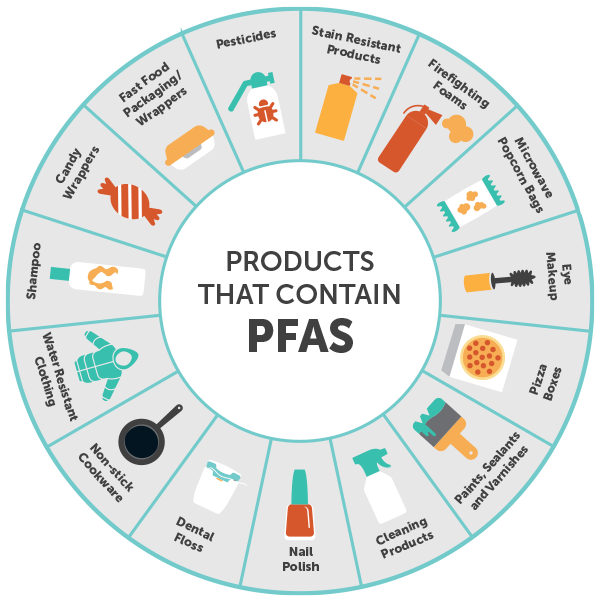By LAUREN D. BROOKS, ESQ.

Under the federal Safe Drinking Water Act (SDWA), the U.S. Environmental Protection Agency (EPA) has the authority to set enforceable National Primary Drinking Water Regulations (NPDWR) for drinking water contaminants and to require the monitoring of public water systems. On April 10, the EPA announced the final NPDWR for six per- and polyfluorinated substances (referred to generally as PFAS). PFAS are a series of synthetic chemical compounds that persist in the environment for long periods of time and bioaccumulate—as a result, they are often called “forever chemicals.”
This regulation will require community water systems and non-transient non-community water systems to conduct extensive monitoring, to post public information about results, and to develop plans to reduce PFAS in accordance with the regulation.
In the 1940s and 1950s, PFAS compounds became widely used in household, commercial, industrial, and military products, such as firefighting foam, nonstick coatings, food packaging, stain resistant items, and fire retardant and waterproof clothing. Scientific research now shows that these chemicals are harmful to human health. Long-term exposure to these chemicals can cause cancer and other serious illnesses. And exposure during critical life stages, such as pregnancy or early childhood, can result in adverse health impacts, too.
In 2002, the EPA’s first notable effort to address the issue commenced, requiring responses to PFAS-contaminated water supplies. The EPA used its authority under the SDWA to do so. Over every subsequent presidential administration, efforts to research the prevalence, health consequences, clean-up methods, and possible need for regulation have gained momentum.

In 2009, the EPA issued the first provisional drinking water health advisory level for PFAS, listing certain compounds for formal evaluation under SDWA to determine if regulation was warranted. From 2014 to 2016, the EPA’s third Unregulated Contaminant Monitoring Rule (UCMR3) listed PFOA and PFOS (PFOA and PFOS are specific perfluorinated chemicals within the umbrella of PFAS) among the list of 30 contaminants of emerging concern. At the conclusion of the UCMR3 testing and reporting period, the EPA issued interim updated drinking water health advisory levels for PFOA and PFOS at 70 ppt (parts per trillion).
As a result, three Florida public water systems identified exceedances of the health advisory levels. In 2018, the Florida Department of Environmental Protection (FDEP) issued provisional soil and groundwater Cleanup Target Levels (P-CTLs) and screening levels for surface water, consistent with the EPA’s health advisory levels.
In 2019, the EPA released the first-ever PFAS Action Plan, which has since been regularly updated. In March 2021, the EPA made the final determination to regulate PFOA and PFOS in drinking water. As a part of that final determination, the EPA indicated it would also evaluate additional PFAS and consider regulatory actions to address groups of PFAS. In 2022, the EPA set interim updated health advisory levels for PFOA at 0.004 ppt and PFOS at 0.02 ppt—drastically lower than the 2016 health advisory levels—and included GenX chemicals at 10 ppt and PFBS at 2,000 ppt.
Meanwhile, the Florida Legislature appropriated $1 million to assist homeowners with private wells contaminated with PFOA and/or PFOS (HB 5001, adopted in 2020); provided $1 million for the University of Florida PFAS Contaminated Material Treatment Pilot Project, and passed HB 1475, which provides that if the EPA has not finalized national standards for PFAS in drinking water, groundwater, and soil by January 1, 2025, then FDEP is required adopt statewide standards.
The NPDWR for PFAS was proposed on March 14, 2023, and the EPA received more than 120,000 public comments. The final NPDWR established legally enforceable levels, called Maximum Contaminant Levels (MCLs), for the individual chemicals PFOA (4 ppt), PFOS (4 ppt), PFHxS (10 ppt), PFNA (10 ppt), and HFPO-DA (known as “GenX chemicals”) (10 ppt), as well as for mixtures of two or more of PFHxS, PFNA, HFPO-DA, and PFBS, using a Hazard Index MCL. The final NPDWR levels appear to be more reasonable than the 2022 health advisory levels that were virtually zero.
The NPDWR for PFAS applies to community water systems and non-transient non-community water systems. Additionally, state, territorial, and tribal agencies will be affected when they assume primary responsibility for implementing and enforcing the regulation. The EPA has identified granular activated carbon, anion exchange, reverse osmosis, and nanofiltration as the best available technologies and methods for meeting the PFAS MCLs.
Public water systems must monitor for these PFAS and have three years to complete initial monitoring (by 2027), followed by ongoing compliance monitoring. Water systems must also provide the public with information on the levels of these PFAS in their drinking water beginning in 2027. Public water systems have five years (by 2029) to implement solutions that reduce these PFAS if monitoring shows that drinking water levels exceed these MCLs.
In Florida, it is anticipated that FDEP will follow the federal standard for drinking water, although the regulation allows the state to create its own standard that meets or exceeds the federal standard. Notably, section 376.91, Florida Statutes, is not limited to drinking water, so FDEP’s focus now turns to whether the EPA will regulate PFAS in groundwater and soil. If the EPA does not do so by January 1, 2025, FDEP must adopt statewide standards for those.
The clock is ticking.
Lauren Brooks is a Senior Attorney at the Tallahassee Office of Lewis, Longman & Walker. Her practice focuses in the areas of local, state, and federal environmental and land use transactions and litigation, including permit challenges, rule challenges, and remediation of contaminated sites.











